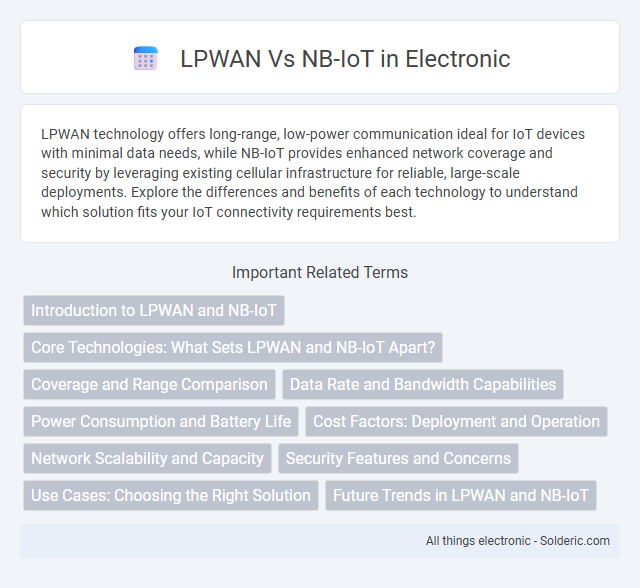LPWAN technology offers long-range, low-power communication ideal for IoT devices with minimal data needs, while NB-IoT provides enhanced network coverage and security by leveraging existing cellular infrastructure for reliable, large-scale deployments. Explore the differences and benefits of each technology to understand which solution fits your IoT connectivity requirements best.
Comparison Table
| Feature | LPWAN | NB-IoT |
|---|---|---|
| Technology Type | Low Power Wide Area Network | Narrowband Internet of Things |
| Frequency Band | Unlicensed (e.g., 868 MHz, 915 MHz) | Licensed LTE spectrum (700-900 MHz) |
| Range | Up to 15 km rural, 2-5 km urban | Up to 10-15 km |
| Data Rate | 0.3 kbps to 50 kbps | Up to 250 kbps |
| Power Consumption | Extremely low, suitable for battery life 10+ years | Low, optimized for 10+ years battery life |
| Deployment Cost | Low, no licensing fees | Moderate, requires operator infrastructure |
| Security | Basic encryption, dependent on protocol | Advanced LTE-grade security |
| Use Cases | Smart metering, environmental sensing, asset tracking | Smart cities, industrial IoT, healthcare monitoring |
| Network Architecture | Star topology with gateways | Cellular network based on LTE |
Introduction to LPWAN and NB-IoT
LPWAN (Low Power Wide Area Network) technology enables long-range communication with minimal power consumption, making it ideal for IoT applications requiring extended battery life and wide coverage. NB-IoT (Narrowband IoT) is a standardized LPWAN technology developed by 3GPP, designed to operate within existing cellular networks, providing secure, reliable connectivity and deep indoor penetration. Your choice between LPWAN variants like NB-IoT depends on factors such as coverage needs, power efficiency, deployment environment, and network availability.
Core Technologies: What Sets LPWAN and NB-IoT Apart?
LPWAN (Low Power Wide Area Network) utilizes unlicensed spectrum and diverse technologies like LoRa and Sigfox to offer long-range, low-power communication ideal for sparse sensor networks. NB-IoT (Narrowband IoT), standardized by 3GPP, operates within licensed LTE bands, providing high reliability, better security, and seamless integration with cellular infrastructure. The core difference lies in NB-IoT's cellular-based architecture ensuring extensive coverage and QoS, whereas LPWAN focuses on flexibility and cost efficiency using various proprietary protocols.
Coverage and Range Comparison
LPWAN technologies generally provide extensive coverage, reaching up to 10-15 km in rural areas, while NB-IoT offers comparable but slightly shorter range, typically around 1-10 km depending on network infrastructure. NB-IoT benefits from cellular-based deployment, ensuring better indoor penetration and urban availability, whereas LPWAN excels in long-range outdoor applications with lower network dependency. Your choice should consider specific coverage requirements, balancing LPWAN's broader rural reach against NB-IoT's enhanced urban connectivity.
Data Rate and Bandwidth Capabilities
LPWAN technologies, including NB-IoT, are designed for low power and long-range communication with limited data rates, typically ranging from 0.3 kbps to 50 kbps. NB-IoT leverages licensed spectrum with bandwidth around 200 kHz, offering better reliability and higher data throughput compared to other LPWAN options like LoRa or Sigfox, which operate on unlicensed bands with narrower bandwidths. Your choice between LPWAN and NB-IoT should consider the trade-off between data rate requirements and network coverage, as NB-IoT supports higher bandwidth capabilities suitable for moderate data transmission needs.
Power Consumption and Battery Life
LPWAN technologies generally offer ultra-low power consumption, ideal for devices requiring multi-year battery life in remote or hard-to-access locations. NB-IoT optimizes power usage through power-saving modes and extended discontinuous reception, significantly extending battery life compared to traditional cellular networks. Your choice of LPWAN or NB-IoT impacts device longevity and maintenance frequency depending on power consumption profiles.
Cost Factors: Deployment and Operation
LPWAN technology generally offers lower deployment costs due to its use of unlicensed spectrum and simpler infrastructure requirements, making it ideal for large-scale, low-power sensor networks. NB-IoT, operating on licensed spectrum, incurs higher licensing fees and network operator charges but provides better Quality of Service (QoS) and secure connectivity, influencing operational expenses. Long-term operational costs for NB-IoT may be higher due to subscription fees, whereas LPWAN benefits from minimal operational costs, especially in private or localized network setups.
Network Scalability and Capacity
LPWAN technologies offer extensive network scalability by supporting thousands of devices per gateway, making them ideal for large-scale IoT deployments in remote or urban areas. NB-IoT leverages existing cellular infrastructure to provide higher capacity and seamless integration with mobile networks, ensuring reliable connectivity and efficient handling of massive device densities in smart cities. Both LPWAN and NB-IoT optimize power consumption and spectrum use, but NB-IoT excels in scenarios requiring enhanced network capacity and QoS management.
Security Features and Concerns
LPWAN technologies, including NB-IoT, implement robust security features such as end-to-end encryption and mutual authentication to protect IoT data transmission. NB-IoT leverages cellular network security protocols, including SIM-based authentication and secure key management, providing enhanced protection against unauthorized access compared to generic LPWAN solutions. Security concerns for both LPWAN and NB-IoT involve potential vulnerabilities in device firmware and network gateways, requiring ongoing updates and monitoring to mitigate risks of data interception and cyberattacks.
Use Cases: Choosing the Right Solution
LPWAN technologies excel in wide-area, low-power sensor networks ideal for agriculture, asset tracking, and smart city applications with infrequent data transmission. NB-IoT offers enhanced security, guaranteed Quality of Service (QoS), and better integration within existing cellular infrastructure, making it suitable for smart metering, industrial automation, and critical healthcare monitoring. Selecting the right solution depends on factors like coverage needs, data frequency, power consumption, and deployment environment to optimize connectivity and operational efficiency.
Future Trends in LPWAN and NB-IoT
LPWAN technologies like LoRaWAN and Sigfox continue to evolve with enhanced energy efficiency and extended coverage, catering to large-scale IoT deployments in smart cities and agriculture. NB-IoT leverages 5G integration to offer improved data rates, ultra-reliable connectivity, and massive device support, positioning itself as a key enabler for industrial automation and smart metering. The convergence of LPWAN and NB-IoT with AI-driven network management is expected to optimize resource allocation and facilitate seamless, scalable IoT ecosystems.
LPWAN vs NB-IoT Infographic

 solderic.com
solderic.com